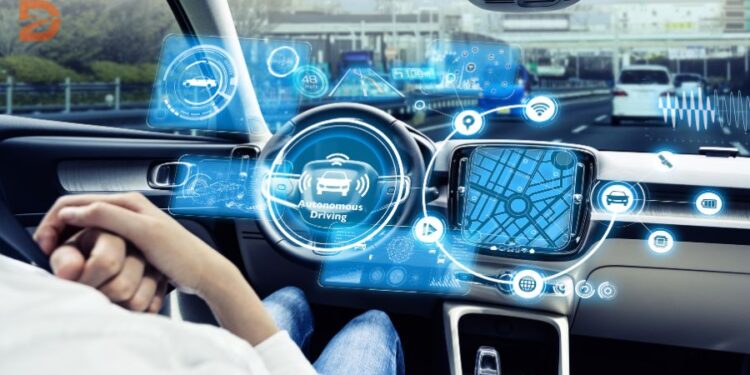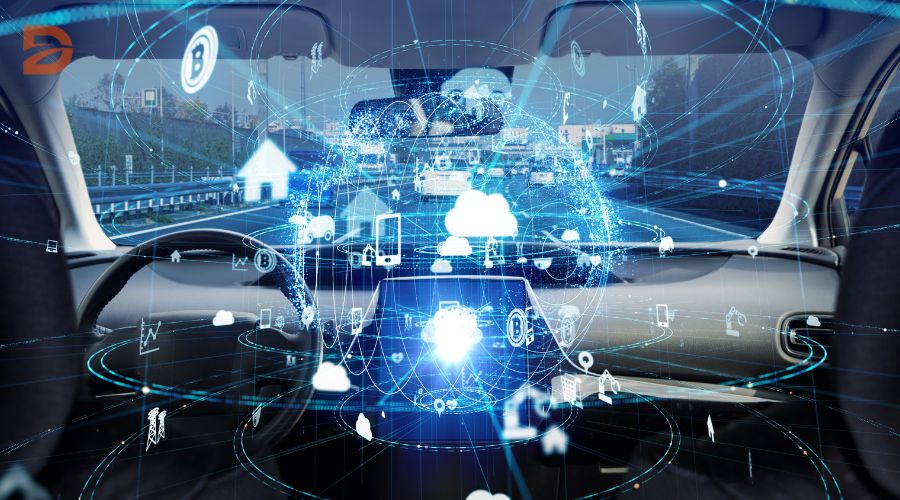In today’s rapidly evolving automotive landscape, your car is no longer just a means of transportation – it’s a highly sophisticated, internet-connected device. With the rise of connected cars, autonomous vehicles, and vehicle-to-everything (V2X) communication, the automotive industry is facing a new challenge: ensuring the cybersecurity of these advanced systems. As the industry is estimated to lose a staggering $505 billion by 2024 due to automotive cyber attacks, the need to safeguard your connected car has never been more critical.
Are you aware that 63% of vehicle cyber-attacks target vulnerabilities that could have been easily solved by a software update? Or that more than 40% of connected vehicle owners have installed third-party apps without verifying their authenticity? These alarming statistics underscore the importance of understanding and addressing the cybersecurity risks associated with your connected car. But where do you begin?
Key Takeaways:
- Connected cars are equipped with hundreds of sensors that transmit data to connected computers, making them vulnerable to cyber-attacks.
- Cyber threats in the automotive industry include physical access to Electronic Control Unit (ECU) systems and exploiting software vulnerabilities.
- Regular software updates are essential for protecting connected cars from security breaches.
- Best practices for connected car safety include removing aftermarket devices, securing key fobs, and avoiding malicious apps.
- Encryption of network communications and monitoring the car’s Controller Area Network (CAN) bus are also crucial for securing connected vehicles.
The Rise of Connected Cars and Cybersecurity Risks
The automotive industry is undergoing a profound transformation, driven by the rise of connected cars. These vehicles, equipped with internet connectivity, can share data with devices inside and outside the car, offering numerous benefits. Streamlined data transfers, real-time GPS navigation with traffic updates, and advanced smart car safety features are just a few examples of the advantages connected cars bring to drivers and passengers.
Benefits of Connected Cars
- Improved driving experience with real-time traffic updates and navigation
- Enhanced safety features, such as automatic emergency braking and lane-keeping assistance
- Remote diagnostics and over-the-air software updates for better vehicle performance
- Seamless integration of infotainment systems and cloud-based services
Types of Cyber Threats in the Automotive Industry
However, the increased connectivity of connected cars also exposes the automotive industry to various cyber threats, including remote hacking and ransomware attacks targeting automotive systems. Experts estimate the industry will lose $505 billion by 2024 due to automotive cyber attacks, as hackers can gain unauthorized access to the car’s communication or software systems to disrupt vehicle functioning.
Some of the key cyber threats facing the automotive industry include:
- Remote Hacking: Vulnerabilities in connected car systems can allow hackers to take control of a vehicle remotely, potentially causing accidents or disrupting critical functions.
- Ransomware Attacks: Malicious software can infiltrate a car’s systems, locking out the owner and demanding a ransom to regain access to the vehicle.
- Supply Chain Vulnerabilities: Weaknesses in the automotive supply chain can expose connected cars to malware and other cyber threats.
- Data Privacy Concerns: The vast amount of data collected by connected cars raises concerns about unauthorized access and potential privacy violations.
“The cybersecurity market for cars was valued at US$186.63 million in 2019, and it is projected to reach US$2460.9 million by 2025, with a notable market Compound Annual Growth Rate (CAGR) of 52.15%.”
As the connected car industry continues to evolve, addressing these cybersecurity risks and ensuring the safety and security of drivers and passengers is of paramount importance.
Critical Components of Automotive Cybersecurity
As the automotive industry embraces the era of connected cars, securing these vehicles against cyber threats has become a critical priority. Strengthening automotive cybersecurity requires addressing several key components, including in-vehicle network security, secure communication procedures, real-time threat detection and prevention, and the safety of the networked infrastructure that connects cars to the outside world.
One essential aspect of automotive cybersecurity is ensuring the security of in-vehicle networks. These complex systems, which integrate various electronic control units (ECUs) and sensors, must be designed with robust access controls and encryption mechanisms to prevent unauthorized access and data tampering. Secure communication protocols, such as encrypted over-the-air (OTA) updates, are crucial to maintaining the integrity of software and firmware within the vehicle.
Intrusion detection and prevention systems (IDPS) play a vital role in monitoring the in-vehicle network for suspicious activities and anomalies, quickly identifying and mitigating cyber threats in real time. These advanced technologies leverage machine learning and behavioral analysis to detect and respond to potential attacks, safeguarding the vehicle’s critical functions and the safety of its occupants.
Beyond the vehicle itself, the cybersecurity of the networked infrastructure that connects cars to external services, such as traffic management systems, cloud platforms, and mobile devices, is equally important. Robust security measures must be implemented to ensure the confidentiality, integrity, and availability of these communication channels, preventing unauthorized access and data breaches.
Addressing the complexities of automotive cybersecurity requires collaboration between vehicle manufacturers, technology providers, and external security specialists. By following industry standards, such as the United Nations Economic Commission for Europe (UNECE) WP29 regulation and the ISO SAE 21434 standard, and adhering to emerging legislative frameworks, the automotive industry can develop a comprehensive and practical approach to safeguarding connected cars against cyber threats.
Best Practices for Automotive Cybersecurity
The Automotive Information Sharing and Analysis Center (Auto-ISAC) has established a set of comprehensive best practices to help the vehicle industry effectively manage cybersecurity threats. These practices encompass various critical components, ensuring a holistic approach to automotive cybersecurity.
Key Cybersecurity Functions
Auto-ISAC’s recommendations focus on seven key cybersecurity functions:
- Incident Response
- Collaboration and Engagement with Appropriate Third Parties
- Governance
- Risk Assessment and Management
- Awareness and Training
- Threat Detection, Monitoring, and Analysis
- Security Development Lifecycle
These functions leverage industry-leading standards and guidelines, such as NIST SP 800-61, ISO/IEC 27035:2011, NIST SP 800-150, ISO/IEC 27010:2012, ISO/IEC 27001, and NIST 800-30, to ensure a robust and comprehensive cybersecurity plan.
Automotive manufacturers and suppliers are encouraged to review these best practices and prioritize stakeholder collaboration, continuous security monitoring, and the integration of security controls throughout the vehicle’s lifecycle, from planning and design to manufacturing and aftermarket services.
“Automotive cybersecurity is a dynamic environment expected to continually and quickly change. The voluntary best practices described serve as a foundation for a risk-based approach to cybersecurity challenges within the automotive industry.”
By adopting these Auto-ISAC recommendations, the automotive industry can effectively mitigate emerging cybersecurity threats and ensure the safety and security of connected vehicles.
Cybersecurity, Connected Cars: Navigating the Challenges
As the automotive industry embraces the era of connected cars, it faces a unique set of automotive cybersecurity challenges. Manufacturers must ensure that all components are secure, protect against malicious actors attempting to gain access or manipulate data, and safeguard customer data security while allowing remote access.
Implementing robust authentication protocols, advanced encryption technologies, and comprehensive access control mechanisms are crucial steps in securing connected cars. Manufacturers must also stay vigilant, continuously monitoring for emerging cybersecurity threats and developing effective incident response strategies to mitigate the impact of potential attacks.
The connected car market is growing rapidly, with Statista projecting over 400 million connected cars by 2025, up from 237 million in 2021. This surge in connectivity brings immense benefits, such as improved road safety and decreased accidents through the collection and analysis of big data. However, it also increases the potential for security vulnerabilities, as demonstrated by incidents like hackers accessing the 360-view camera of Kias through telematics systems and automotive APIs.
| Key Challenges in Automotive Cybersecurity | Recommendations |
|---|---|
|
|
Navigating the complex and rapidly evolving automotive cybersecurity landscape requires a multifaceted approach. Manufacturers must integrate security and privacy considerations into the core of their product development and service offerings, ensuring that their connected car solutions are both user-friendly and secure.
Automotive Cybersecurity Regulations and Compliance
As the automotive industry continues to embrace connected and autonomous technologies, ensuring the security of these systems has become a top priority. Regulatory authorities have responded by introducing measures to address the growing cybersecurity risks in the automotive sector.
Automated Vehicles Comprehensive Plan (USDOT)
The U.S. Department of Transportation (USDOT) has developed the Automated Vehicles Comprehensive Plan, which outlines requirements for vehicle authentication, encryption, data protection, and secure communications protocols. This plan aims to establish a framework for the safe and secure deployment of automated vehicles on public roads.
Proposed Federal Regulations for Automotive Cybersecurity
In addition to the USDOT’s Automated Vehicles Comprehensive Plan, the U.S. federal government has proposed several regulations to address automotive cybersecurity regulations. The SPY Car Act and the SELF-DRIVE Act, for instance, mandate automakers to adhere to cybersecurity frameworks and obtain consent from vehicle owners before collecting personal data.
Compliance with these federal regulations for automotive cybersecurity is critical for automotive companies. Failure to meet these requirements can result in fines and potential legal issues, while also jeopardizing the safety and data protection of their customers. Compliance with these regulations is essential for the automotive industry to maintain public trust and ensure the security of connected vehicles.
“Collaboration between automotive manufacturers, governments, and the cybersecurity community is essential for addressing emerging threats and establishing effective cybersecurity measures in vehicles.”
The USDOT Automated Vehicles Comprehensive Plan and proposed federal regulations for automotive cybersecurity demonstrate the growing importance of compliance in the connected car ecosystem. By adhering to these regulatory frameworks, automotive companies can protect their customers, avoid legal and financial consequences, and contribute to the overall safety and security of the industry.
Communication Technologies and Vulnerabilities
Connected vehicles rely on various communication technologies, such as networked electronic control units (ECUs), vehicle-to-infrastructure (V2I) communication, vehicle-to-vehicle (V2V) communication, and vehicle-to-device (V2D) communication. While these technologies offer benefits like improved safety and efficiency, they also introduce new vulnerabilities that cybercriminals can exploit.
Networked Electronic Control Units (ECUs)
Networked ECUs enable seamless integration and information sharing within a vehicle, but they also create potential entry points for hackers. Vulnerabilities in ECU software or communication protocols can allow unauthorized access, potentially leading to the manipulation of critical vehicle functions.
Vehicle-to-Infrastructure (V2I) Communication
V2I communication allows vehicles to interact with the environment, gathering data about traffic flow and road conditions. However, this connectivity also increases the risk of cyberattacks, as hackers could potentially access sensitive information or disrupt the communication network.
Vehicle-to-Vehicle (V2V) Communication
V2V communication enables vehicles to share information like speed, position, and direction, which is necessary for autonomous driving. Ensuring the security and integrity of these communications is crucial to prevent malicious actors from accessing and manipulating the data.
Vehicle-to-Device (V2D) Communication
V2D communication permits mobile devices to connect with vehicles remotely, which can provide convenience but also increase the risk of cyberattacks. Hackers could potentially gain access to vehicle systems through vulnerabilities in the V2D communication protocols.
Securing these communication technologies is essential to protect connected vehicles from cyber-attacks. Established security measures, such as encryption, authentication protocols, and secure communication protocols, are vital in mitigating the risks associated with networked ECUs, V2I, V2V, and V2D communication.
| Communication Technology | Potential Vulnerabilities | Recommended Security Measures |
|---|---|---|
| Networked Electronic Control Units (ECUs) | Unauthorized access, manipulation of critical vehicle functions | Secure software development, robust access controls, regular updates |
| Vehicle-to-Infrastructure (V2I) Communication | Data breaches, disruption of communication network | Encryption, authentication protocols, secure communication protocols |
| Vehicle-to-Vehicle (V2V) Communication | Manipulation of data compromised autonomous driving functions | Encryption, message authentication, secure communication protocols |
| Vehicle-to-Device (V2D) Communication | Unauthorized access to vehicle systems, data breaches | Strict access controls, secure communication protocols, regular updates |
Securing Connected Vehicles: A Comprehensive Approach
Protecting connected vehicles from cyber threats demands a multifaceted strategy that addresses the various layers of the automotive ecosystem. At the core of this approach lies the implementation of robust authentication, encryption, and secure firmware update mechanisms to safeguard the underlying software and firmware from vulnerabilities.
Alongside these foundational security measures, anomaly detection systems and rapid incident response protocols are essential for identifying and mitigating cyber threats in real-time. By constantly monitoring the vehicle’s systems and swiftly responding to anomalies, these solutions help maintain the integrity and safety of connected vehicles.
Furthermore, end-to-end cybersecurity solutions that cover the entire vehicle lifecycle, from design to disposal, are crucial to ensure the safety and privacy of connected vehicles and their occupants. These comprehensive strategies address the unique challenges posed by the evolving landscape of connected vehicle security, cybersecurity solutions, and emerging technologies like autonomous driving.
As the automotive industry continues to embrace the benefits of connectivity, the need for a holistic approach to connected vehicle security becomes increasingly evident. By prioritizing authentication, encryption, secure firmware updates, and real-time incident response, automakers and technology providers can safeguard the future of connected transportation and enhance the overall driving experience.
Conclusion: Prioritizing Automotive Cybersecurity
As the automotive industry continues to evolve, with vehicles becoming more connected and technologically advanced, the need to prioritize automotive cybersecurity has become increasingly critical. Cyber threats to connected cars pose not only a risk to public safety but also a threat to data privacy. By understanding the vulnerabilities in modern vehicle communication technologies and implementing comprehensive cybersecurity measures, automakers and drivers can work together to protect connected vehicles from malicious attacks.
Adhering to industry cybersecurity best practices, staying up-to-date with regulations, and fostering collaboration across the automotive ecosystem are essential steps in securing the future of connected transportation. As the number of automotive API attacks and keyless car thefts continue to rise, the automotive industry must remain vigilant in addressing these emerging threats to maintain consumer trust and ensure the safety of drivers, passengers, and the public.
By prioritizing automotive cybersecurity, the industry can ensure that the benefits of connected and autonomous vehicles are realized without compromising the safety and privacy of drivers and the public. This collaborative effort between automakers, cybersecurity experts, and regulatory bodies is crucial in establishing industry-wide standards and mitigating the growing tide of cyber threats in the automotive sector.
FAQ
What are the key cybersecurity risks facing connected cars?
The increasing connectivity in modern vehicles exposes the automotive industry to various cyber threats, including remote hacking, data breaches, and ransomware attacks that can disrupt vehicle functioning. Experts estimate the industry will lose 5 billion by 2024 due to automotive cyber-attacks.
What are the critical components of an effective automotive cybersecurity strategy?
Securing connected vehicles requires a comprehensive approach, including securing in-vehicle networks, implementing secure communication procedures, integrating real-time threat detection and prevention technologies, and ensuring the safety of the networks that connect cars to infrastructure.
What are the best practices recommended by the Automotive Information Sharing and Analysis Center (Auto-ISAC) for automotive cybersecurity?
Auto-ISAC recommends developing a thorough cybersecurity plan, facilitating the exchange of insights and best practices among stakeholders, and emphasizing the importance of continuous security measure monitoring and upgrading. Incorporating cybersecurity throughout the vehicle’s lifecycle is also a key recommendation.
How are regulatory authorities addressing cybersecurity in the automotive industry?
Regulatory authorities have introduced measures such as the Automated Vehicles Comprehensive Plan developed by the U.S. Department of Transportation (USDOT), which outlines requirements for vehicle authentication, encryption, data protection, and secure communications protocols. Additionally, the U.S. federal government has proposed standards like the SPY Car Act and the SELF DRIVE Act, which mandate automakers to adhere to cybersecurity frameworks and obtain consent from vehicle owners before collecting personal data.
What are the key communication technologies in connected vehicles, and how can they be secured?
Connected vehicles rely on various communication technologies, such as networked electronic control units (ECUs), vehicle-to-infrastructure (V2I) communication, vehicle-to-vehicle (V2V) communication, and vehicle-to-device (V2D) communication. Securing these communication technologies is crucial to protect connected vehicles from cyber attacks, and this involves implementing robust authentication, encryption, and secure firmware update mechanisms.
What is a comprehensive approach to securing connected vehicles?
Securing connected vehicles requires a multilayered approach that addresses various aspects of the automotive ecosystem, including implementing strong authentication, encryption, and secure firmware update mechanisms, as well as anomaly detection systems and rapid incident response protocols. End-to-end cybersecurity solutions that cover the entire vehicle lifecycle are crucial to ensure the safety and privacy of connected vehicles and their occupants.











